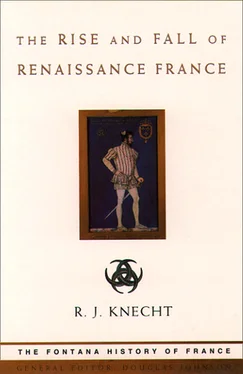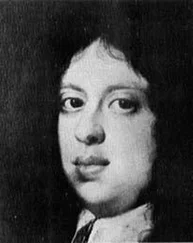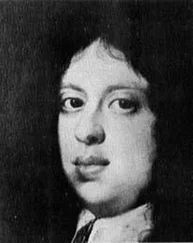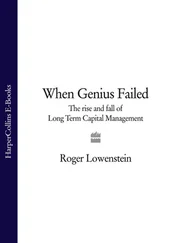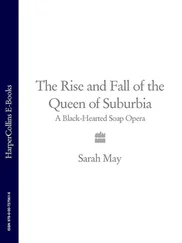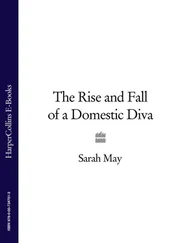There were many routes to membership of the council: birth, skill in law, diplomacy or administration, regional importance, ecclesiastical dignity and the influence of patrons and relatives. Councillors served at the king’s pleasure, not for life, and membership was not hereditary. Some councillors served under all three kings from 1483 to 1526, but membership was usually for shorter periods. The council was not only a point of contact between the crown, the nobility and local communities; it was also a tool which the crown used to secure the obedience of the governing classes and to arbitrate between them.
The body responsible for turning the council’s decisions into laws was the chancery, headed by the Chancellor of France. He was invariably an eminent jurist, who had served his apprenticeship in a parlement, and sometimes he was also a high-ranking churchman. His powers and duties ranged more widely than those of any other great officer of the crown. In effect, he was a kind of prime minister. As head of the royal chancery, he kept the Great seal and other seals of state. All documents emanating from the king and his council were drawn up in the chancery and sealed in the chancellor’s presence. He had to ensure that the text of each document matched the orders received, and could refuse to seal any that seemed incorrect. This power, moreover, extended to all the other chanceries in the kingdom, including those of the ‘sovereign courts’. The chancellor’s authority was, therefore, nation-wide. His influence on legislation was also crucial. He exercised it not only as a councillor but also by drafting royal edicts himself. As head of the judicial administration, he was by right entitled to preside over any sovereign court, including the parlement. He appointed judges and received their oaths of office unless they had already sworn them before the king. The chancellor attended the king’s council regularly and took the chair in the king’s absence. He helped to determine policies and explained them, if necessary, to the parlement. Now and again he served on major diplomatic missions. He was appointed for life by the king, but, if necessary, his functions could be performed by a Keeper of the Seals, who did not have his prestige or influence.
The chancery was the nearest equivalent to a modern ministry. In 1500 it had a staff of 120 which grew even larger during the sixteenth century. Unlike the ‘sovereign courts’, it continued to follow the king on his travels. Originally, all the chancery clerks drew up documents to be sealed by the great seal, but during the Middle Ages they began to specialize: the clercs du secret drafted documents emanating directly from the king; in time they became known as secretaries. Under an ordinance of 1482 notaries of the chancery were effectively granted a monopoly of drawing up and signing all royal acts, chancery letters, conciliar decisions and decrees of the ‘sovereign courts’. They were automatically ennobled and enjoyed the privilege of committimus as well as numerous tax exemptions. The quantity of documents processed by them was enormous.
Closely associated with the chancellor were the masters of requests ( maîtres des requêtes de l’hôtel ). There were eight of them about 1500, but their number increased rapidly thereafter. Under an edict of 1493 they were authorized to preside at the courts of the bailliages and sénéchaussées , to receive complaints against local officials and to correct abuses. They could preside at the Grand conseil and sit in the parlement, where they ranked immediately below the presidents. The masters of requests were often given temporary commissions in financial, diplomatic and judicial affairs. They were the ancestors of the intendants , who became the principal agents of royal centralization in the seventeenth century.
The Great Council ( Grand conseil ) was an exclusively judicial body which had taken over part of the work formerly exercised by the king’s council: it investigated complaints against royal officials, intervened in conflicts of jurisdiction between other courts and could revoke enactments that the parlement had registered. It also acted as a court of appeal and of first instance for a wide range of lawsuits. Though the Great Council’s procedure was fairly simple and relatively cheap, it had one serious disadvantage for suitors: like the king’s council, it continued to follow the king on his travels through the kingdom. It carried its records around, and suitors had to change their lawyers as it moved from place to place. Because of its closeness to the king’s person, the Great Council was more susceptible to his influence than was the parlement, and he often used it to bend the law to his interest.
The king of France was first and foremost a judge, and the earliest form of royal intervention at the local level had been the establishment of officials charged with exercising justice in his name. At the bottom of the hierarchy, but above the judges of the feudal courts, were magistrates, called prévôts , viguiers or vicomtes , whose powers were limited to the simplest cases. The basic unit of local government was the bailliage (sometimes called sénéchaussée ). The kingdom comprised about 100 such units, which could vary enormously in size. By the sixteenth century, the official in charge of the bailliage , the bailli (or sénéchal ), had purely honorific or military duties (for example, he summoned the feudal levy, called the ban et arrière-ban ), but the tribunal of the bailliage , under the bailli ’s deputy or lieutenant and his staff, was a hive of activity, bustling with barristers, solicitors, sergeants and ushers. The bailliage judged on appeal cases sent up from inferior courts and in first instance cases concerning privileged persons or cas royaux. These were crimes committed against the king’s person, rights and demesne, ranging from treason and lèse-majesté to rape and high-way robbery. In addition to their judicial competence, the bailliages had important administrative powers: they published royal statutes and issued decrees of their own.
Above the bailliages were the parlements of which there were seven in 1500: Paris, Toulouse, Grenoble, Bordeaux, Dijon, Rouen and Aix-en-Provence. The oldest and most prestigious was the Parlement of Paris which had ‘gone out of court’ in the thirteenth century and was now permanently based in Paris in the old royal palace on the Ile de la Cité. Though separate from the king’s council, the parlement was still considered to be part of it: thus peers of the realm were entitled to sit in it and when the king came to the parlement, accompanied by his ministers and advisers to hold a lit de justice , the old Curia regis was in effect reconstituted for the occasion. The parlement’s view of royal absolutism differed from the king’s: while admitting that authority resided in the king’s person, it did not believe that he could treat the kingdom as he liked. He was its administrator, not its owner, and was bound to observe the so-called ‘fundamental laws’ governing the succession to the throne and preservation of the royal demesne. The parlement’s view implied a distinction between the sovereign as an ideal and the fallible creature who occupied the throne. It saw its own function as that of protecting the interests of the ideal sovereign from the errors that the human king might commit. The parlement’s magistrates liked to compare themselves to the senators of ancient Rome, an analogy resented by the king. In 1500 the Parlement of Paris consisted of five chambers: the Grand’ chambre , two Chambres des enquêtes , the Chambre des requêtes and the Tournelle criminelle , with a combined personnel of about sixty lay and clerical councillors.
Читать дальше
